Three Days and a Pit Oven: How the Best Barbacoa Is Made
A glimpse into the labor and love that make traditional lamb barbacoa at a Mexico City family restaurant.
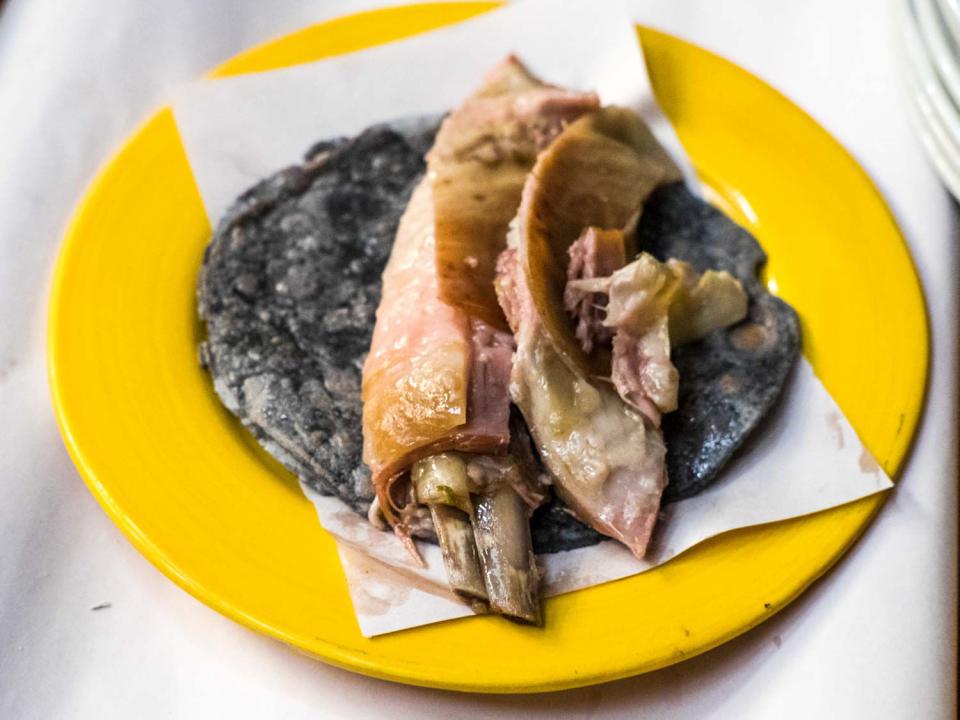
Serious Eats / Naomi Tomky
Against the world's greatest delicacies, Hidalgo-style barbacoa holds its own. The whole lamb cooks overnight in its own juices, wrapped in agave leaves over a low fire, and emerges sticky with fat and imbued with smoke from the wood coals and lightly charred leaves, ready to be shredded and wrapped in warm tortillas for hungry eaters.
I first fell in love with the meltingly tender meat in a small town outside of Querétaro, Mexico. In the 15 years since, finding the best barbacoa has been something of a mission for me. I’ve returned to San Juan del Río, where I first found it, and explored the sprawling metropolis of Mexico City and its environs, expressly for the dish. I've even sought it out around the US, in Seattle, in Austin, and in Los Angeles.
But the actual mechanics of cooking it were a bit of a mystery to me until the family behind Barbacoa Renatos, which some claim serves the best barbacoa in Mexico City—and which is one of the few small venues where the pit-cooked lamb is made on-site, rather than cooked in neighboring Hidalgo or México state and brought into the city—invited me to observe their three-day process, culminating on Sunday, when barbacoa is traditionally served.
The origins of pit-cooking meat trace back to the Taíno people in the Caribbean, during the pre-Columbian era, but the technique migrated west to central Mexico, leaving a trail of underground ovens, like the pibils in the eastern part of the country. The word barbacoa is thought to come from an indigenous word meaning "framework of sticks" or "sacred firepit," though some say it came from the Spanish phrase de la barba a la cola, or "from the beard to the tail."
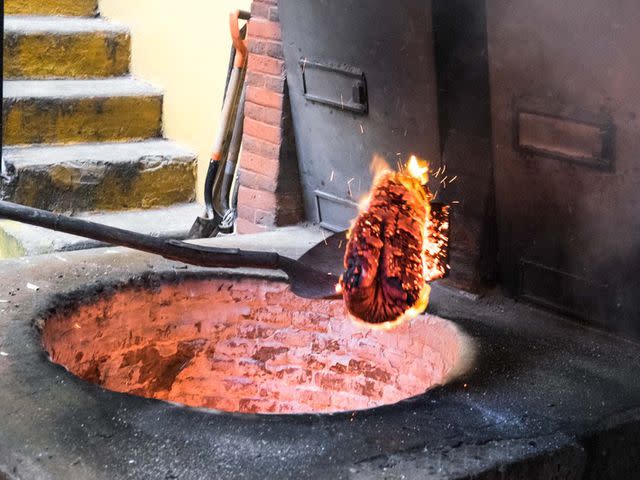
Serious Eats / Naomi Tomky
According to the book Pre-Hispanic Mexican Cuisine: The Food of the Ancient Mexicans, which Barbacoa Renatos has used as a source, the Mayans came up with the technique of steam-cooking meat in underground ovens, which keeps both the juices from the animal and the smoke and heat from escaping and forces them back into the meat, resulting in big flavor and preventing any drying out. The method was in use at the time of the Spanish arrival in Mexico, and little about it has changed in the centuries since. Renato, Adriana, and Bruno Álvarez Cruz, the siblings in charge of running Renatos today, say that their specific technique for making barbacoa has been passed down for at least three generations.
Making Barbacoa: Day One and Two
I arrive at Renatos on Saturday, the second of three days of preparation. On Friday, Adriana went to the meat vendor at 3 a.m. to pick out lambs at the butcher shop. If she were to arrive any later, the best lambs—small, tender, barely a year of age, brought in from ranches in Veracruz or Hidalgo state—would all be long gone.
Until recently, shopping for the lamb and other ingredients was done by her father, Renato Álvarez Rentería, who learned the art of barbacoa from his father, Alejandro Álvarez Solano. Fifty-eight years and three generations later—four when Adriana’s 11-year-old son, Javier, helps out—barbacoa remains the family business. This spring, the elder Renato had some serious health issues, requiring his children and their spouses to step in and take over.
When Adriana returned home with the lambs on Friday, they were salted and left to cure overnight. By the time I arrive at 8:30 Saturday morning, Renato is focused on starting the fire in the hoyo, or pit oven: a large square of brick and cement, rising about two feet from the ground floor of the Álvarez home, with a circular, brick-lined well descending another four or so feet belowground. A thick layer of black soot covers the adjacent walls, climbing past the two floors that make up the family's living space and up to the ceiling.
Standing atop the still-warm coals from last week, resting his head on the shoulder-level top of the oven in the center of his house, Renato says a silent prayer. "I’m asking that it goes well," he tells me, before lighting the fire of pine and eucalyptus wood. It's my first hint that what I'd always considered a sacred Sunday ritual for food lovers like myself has its own spiritual side.
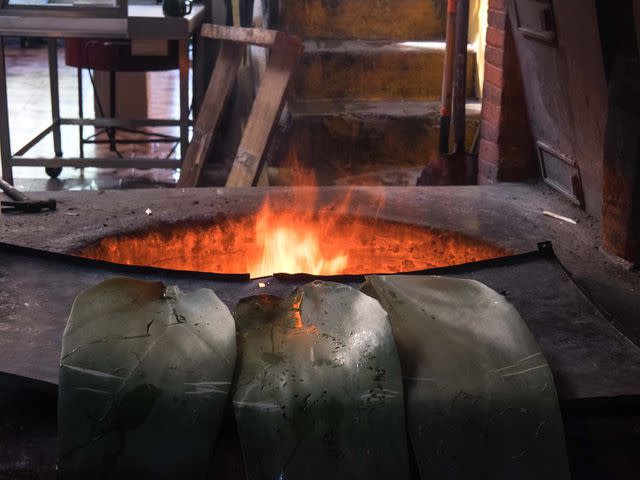
Serious Eats / Naomi Tomky
Once the fire is roaring and flames are whipping out of the top of the oven, Renato turns to the meat: about three and a half lambs, broken into nine pieces each. Their standard order used to be five lambs, but, as Adriana tells me, with gas prices rising and uncertainty over the upcoming presidential election leading some customers to rein in their spending habits, they’ve cut back.
At 9:30 on Saturday morning, as Renato soaks the lamb for 20 minutes to remove the salt, it seems so far—and will for most of the weekend—that 90% of making barbacoa is cleaning. First, the entire bottom floor and entrance to the house are scrubbed. By the time the first of the 300 or so customers comes in on Sunday morning, each piece of lamb after its desalination soak, each vegetable and fruit for salsas and drinks, along with every pot, pan, and table, will have been washed over and over.
That includes the palenques, the tall, slender leaves of the maguey plant, which fold into a packet to hold the meat when it goes into the oven. After cleaning, Renato and one of the restaurant's employees, Ana, lay the leaves on a piece of hot metal over the still-orange flames of the fire to soften them and add a bit of charring flavor. They look for the leaves of older plants for width and length, so they can use fewer of them and fold them over the meat more easily. The maguey leaves impart some of their own flavor—usually described as rich or caramel-like—and function to keep many of the lamb's own juices in.
Over a breakfast of chilaquiles and tostadas de tinga washed down with sweet, weak coffee, I learn more about the business’s past. Adriana and Renato’s mother, María Eugenia Cruz Guzman, now retired, tells her own barbacoa history.
"I was pura borrega myself," she laughs, comparing herself to the young lambs they cook. At age 17, while selling chickens at the local market, she met the elder Renato, shopping for his family’s barbacoa business, and they got married. At the time, 46 years ago, “everything was artisanal, everything was done completely by hand,” she says. The process took many more days and included burning the hair off the legs of lamb and cleaning the spikes from the giant nopal (cactus) leaves that come on the garnish plate—tasks now done by the vendors.
Ten years after marrying, they moved to the current house. Until recently, she and her husband did all of the barbacoa work while Adriana and Bruno had other jobs—Renato still does, as a history teacher at a secondary school. When she cooked, Renato tells me, I could never have gotten this insider glimpse: “She wouldn’t let anyone from outside the family in, because if she did, the fire would get angry and leave the meat raw.” It was starting to become clearer to me why, despite my long-held love of the meat, I'd never fully understood the process.
Looking into the hellmouth of an oven, it seems hard to believe anything could exit raw. As we wait for the flames to change from red or orange to blue—“We go only by our eyes,” he says, “never by temperature”—Renato begins the final preparation of the meat with a last sprinkling of salt.
He sets a large, round metal cage on a folding table, then folds each of the five-foot-tall maguey leaves into the cage so they poke out from its center and climb the side, splaying them out at the top. Inside this lining of palenques, he carefully places the lamb, all the pieces except the ribs, which he’ll set on top. The lamb, mostly in a single layer, takes up about two-thirds of the pot. A few avocado leaves go in for additional flavor.
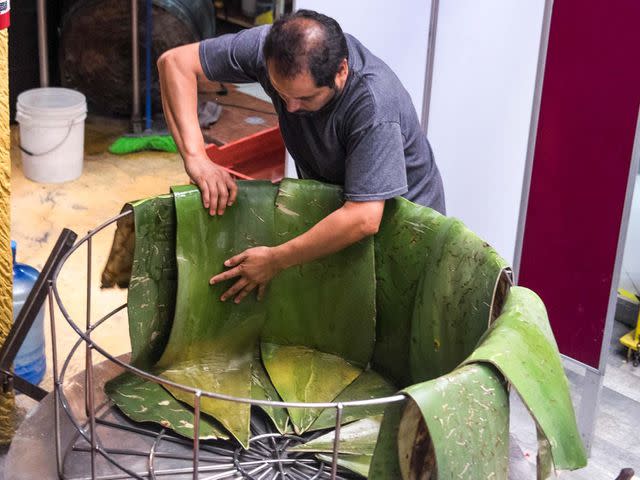
Serious Eats / Naomi Tomky
In the remaining space, Renato adds the contents of a yellow bucket labeled panza—which translates to "belly," though the bucket actually contains finely chopped and marinated lamb heart, lungs, and intestine, stuffed into a pair of lamb stomachs. Poking holes in the stomach with a sharp knife so it doesn’t balloon up and explode, he then covers it all with caul fat to keep it from drying out.
When all is arranged, he bends the leaves, previously folded back over the edge of the cage, gently over the top, then stabs a series of butter knives through them to form a stable, prettily wrapped package. He hooks the cage into what looks like a medieval torture device, but is in fact a pulley system with four chains that attach to the side, allowing one person to maneuver the heavy cage of meat alone. The contraption, fixed to a metal track on the ceiling, is only about three years old, part of efficiency improvements that helped bring the entire barbacoa preparation process down from four to three days. Bruno, Adriana and Renato’s brother, wrote a graduate-school thesis on streamlining the business, and the family put many of his ideas into place.
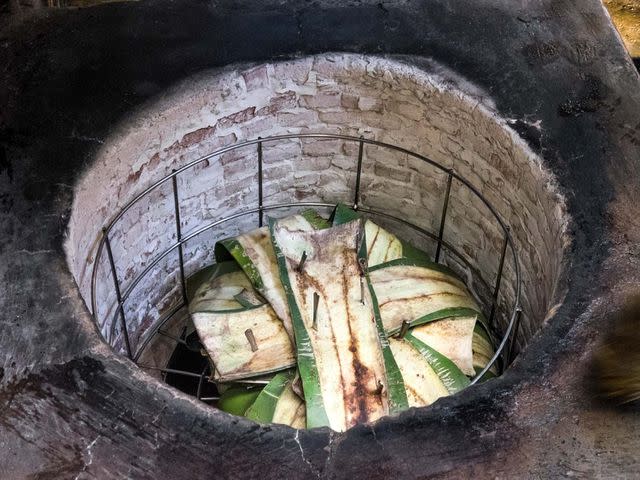
Serious Eats / Naomi Tomky
At 1:15 in the afternoon, almost five hours after he started building the fire, Renato declares the flames blue, and thus ready. He uses a long-handled shovel to pull out the still-flaming chunks of eucalyptus wood, whose burning characteristics were desired for the fire but whose smell would change the flavor of the meat. As he flings fragrant fireballs up from the inferno, Ana douses them with water, and a hiss echoes around the room, momentarily drowning out the music coming from his phone.
Using a rope woven under two handles, he and Ana carefully lower the pot of ingredients for the consomé—a soup flavored with barbacoa drippings and lamb feet—onto the coals at the bottom, then add water from huge multi-gallon jugs. The metal cage with the meat in it goes down next, via its pulley-chain device. By the time the lamb pouch reaches the bottom, the intense heat of the oven has already brought the consomé to a boil.
The pair line the top edge of the oven with wet newspaper, put on the oven’s metal cover, then add more newspaper on top, followed by a thick layer of dirt and sand that holds the heat in. A plastic tarp goes over it all, and the day’s work, aside from a little more cleanup, is done.
Making Barbacoa: Day Three
The next day, work starts again at 5 a.m. Formerly housing a maze of stacked tables and chairs, plus parking space for a motorcycle, the front of the ground floor is transformed into a dining room. Renato pulls the plastic tarp off the oven, and wisps of smoke seep through the dirt and rise to the ceiling. He shovels the dirt carefully, returning it to the wall-mounted metal containers from which it came. Then the newspaper is gathered up and stored in a crate for use again next week.
Using a rope, Renato works with Adriana’s husband, Javier Sr., to pull the meat up a few feet. The green palenques have warmed over to a soft and murky brown; the knives that once stood erect to sharply seal them are now atilt and loosely hanging on. Javier straddles the oven and deftly swipes open the leaves with a knife, pulling out a few nibbles of the barbacoa. The air fills with the gentle but all-encompassing aroma of long-cooked lamb. A square table is placed into the oven, then the meat set on top of it. Now that the meat is raised a few feet from the floor of the oven, it can easily be reached during service while it’s still warm, even when the oven is covered.
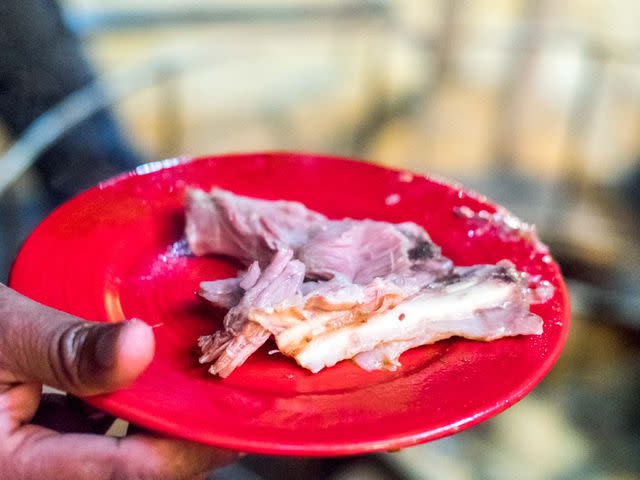
Serious Eats / Naomi Tomky
Javier hands me a red plastic plate with the pile of meat he retrieved. I taste it, surprised at the magic achieved by a night in the oven. It's the same as other barbacoa I've had, but better—slippery with its own juices, sticky with fat, rich, smoky, and beguiling. I taste every hour of its time in the oven, every minute of Renato's fire-lighting, every second of Adriana's early-morning shopping.
The rest of the team shows up: a waitress and two assistants, a tortilla-maker, two salsa-makers, and a dishwasher, all of whom assist the family on Sundays. Besides the traditional red and green salsas, they’ll make salsa borracha—a condiment that earns its “drunk” name from the pulque (a pre-Hispanic alcoholic beverage made from the fermented liquid of the agave plant) that gets mixed with pasilla chiles, fried onions, garlic, pepper, and oregano—and guacamole, which includes pipicha, a new-to-me twiggy herb with the brightness of mint but the complexity of cilantro. “Barbacoa is strong,” Renato explains. “Everything else is designed to temper it.”
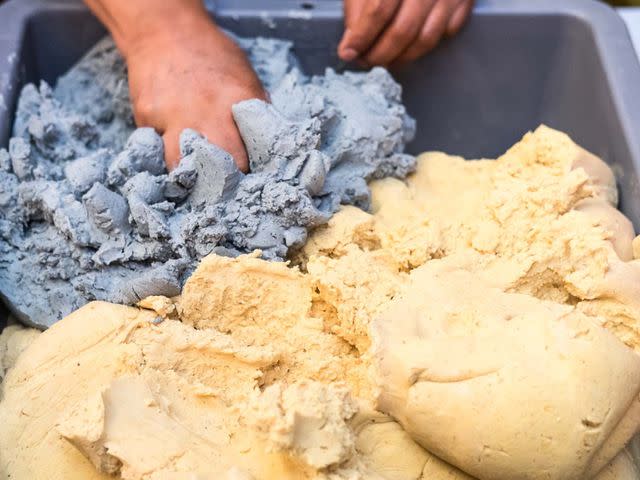
Serious Eats / Naomi Tomky
While the sauces come together and the still-warm fresh masa (corn dough), delivered that morning, is mixed with water to make tortillas, I join the father and son Javiers for a shopping excursion. “Normally he joined his grandfather for this,” says the elder Javier of his son. Now, with the elder Renato in the hospital, the younger Javier guides his father to find the last-minute pre-service items.
First, they head to a market for flowers to decorate the tables, where the woman knows the order and asks after her ailing customer. Inside, another lady produces crushed ice by feeding a giant frozen block through an ancient-looking machine; Renatos will use the ice under the salsas to keep them cold through service. Then on to a bakery, for various pastries and the bolillos (rolls).
Javier stops the minivan at a lonely-seeming bucket of hot lard, tucked into the side of a roundabout. A man runs up, and Javier asks for the chicharrones, which get fried to order. The vendor uses a set of tongs in each hand, deftly plunging them into the boiling fat, to unfurl the cooking pork skin. While it bubbles and pops, the younger Javier runs across the street for tamales, which will be stuffed into the bolillos as hearty sandwiches (tortas de tamal) for the team before service.
At 8:30 a.m., the team gathers for a quick meeting to go over reservations, flavors, and specials, and to scarf down the tamale sandwiches with mugs of coffee before the doors open. The first customer walks in 15 minutes later. Now, suddenly, like color filling in a black-and-white movie, the magic of the two previous days of work comes together into the familiar choreographed dance of restaurant service.
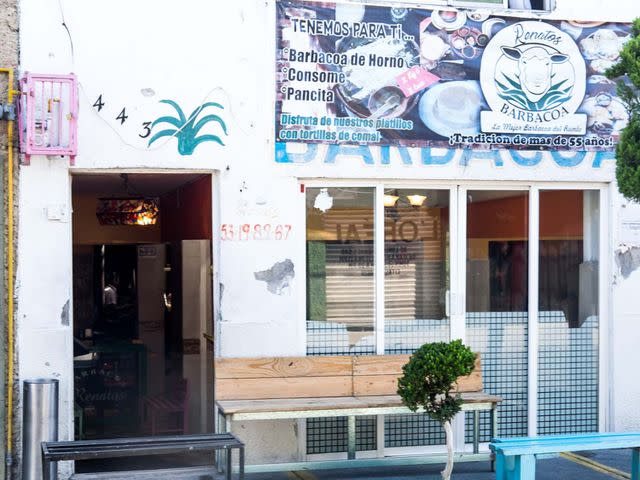
Serious Eats / Naomi Tomky
Ana pinches the edges of masa cakes into sopes and slaps blue-corn tortillas onto the grill. Elena, another of the workers, arranges salsas over ice for one station and into tiny bowls on a plate to send out to customers. Adriana hands out the leather-bound menu and takes orders, while Bruno consults with a customer looking to book a party. About $26 buys a kilogram of barbacoa, $1.50 a bowl of consomé, and $3 a barbacoa taco or four fried barbacoa flautas. Many tables order the combination packages—for $30, you get four large consomés, half a kilo of meat, the upgraded garnish plate, four glasses of the day's aguas frescas, and 18 tortillas, enough to feed four people.
Each time an order for barbacoa comes in, Renato removes the cover to the oven and leans into the hole, belly on the edge and head inside, shoveling meat onto a plate. Treasure unburied, he stands up and turns to his chopping station. An employee named Jorge jokes and teases the other employees as he washes dishes. Garnish plates, stacked high with pápalo, nopales, avocado, and chicharrones, head out of the kitchen, met by bowls of consomé, tacos, sopes, flautas, and tortillas filled with cheese and barbacoa, called quesacoas.
I eat through the menu, reflecting on the process as I watch customers come in. I wonder how many of them understand that they're sitting in the basement of a family home, eating the product of four generations of experience, of three days of labor. I wonder whether they can taste, amid savory bites of taco, that making barbacoa is a ritual.
Later, friends will ask if I'm convinced that it's the best in the city. I haven't tried all the barbacoa that's out there, an impossible feat in a city with tens of millions of people. But Renatos has at least ended my search for the best—now, I head straight there when I'm in town.
A table of nine comes in, and the place seems lively. But Adriana disagrees, telling me it’s a slow start for them. Both she and Renato, separately, confess a little worry about the business. For the month that their father has been ill, the events—parties, baptisms, weddings—that usually happen in this space on Saturdays have all been canceled. In addition to her father’s health concerns and the country's state of flux ahead of the election, the barbacoa business has the usual problems that accompany making traditional food in a modern world. “It’s hard now,” she says, “because there’s so much competition.” Fast food restaurants, malls, and markets are all over.
They’re down to selling only 40 to 50 cooked kilos of meat (about 80 to 90 kilos raw) per week, at a business that, her mother says, once did five times that. Renato shrugs. What will happen to the business, this family tradition making its way down to a fourth generation, is up in the air as its patriarch ails. It is a decision he, Adriana, Bruno, and another brother who currently lives in Cancún will need to make. "In this economy," he says, "simple things can break a business."
But in nearly the same breath as each expresses concern, they dive, wholeheartedly and often whole-bodily, into the making of barbacoa, as did their parents and their grandparents before them. The oven, its bricks and cement and trails of soot dusting the walls above it, forms the center of the family home, and so too, on a less tangible level, does the weekend task of making barbacoa. Economies have ups and downs, but the Álvarez Cruz family blood seems to run with the juice of lamb, cooked low, slow, and in an oven built by their father’s hands.
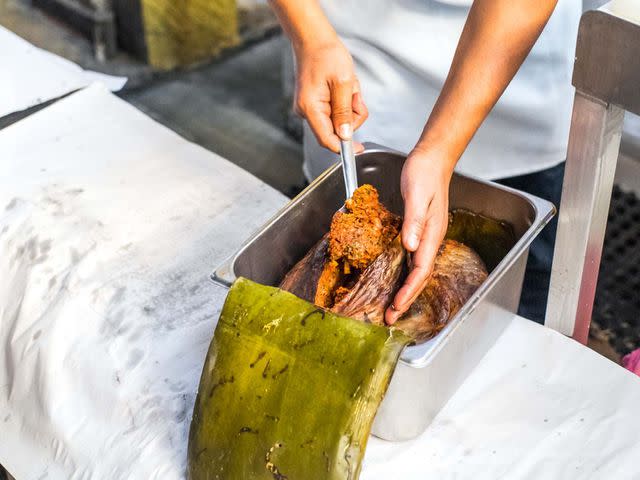
Serious Eats / Naomi Tomky
December 2018
Read the original article on Serious Eats.

